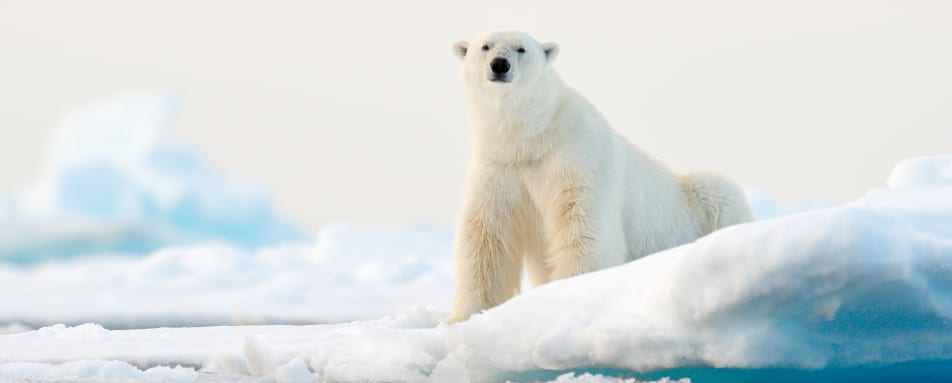Regions to Visit in the Arctic
The scenery in the Arctic steals the show. It’s sparkling ice sheets, vast glaciers and awe-inspiring icebergs have captivated many imaginations; once you’re there, it's not hard to see why so many intrepid explorers have been drawn here.

Venture into a remote wilderness of overwhelming beauty, to a place rich in wildlife and one of the last remaining untouched areas on planet earth. Below is our helpful guide to where's best to see what.
Iceland
Iceland is situated in the Nordic region and whilst is does not sit within the Arctic circle, its proximity to Greenland and Baffin Island means it’s a great starting point for Arctic expedition cruising. This standalone island has plenty to offer from vast landscapes, active volcanoes, geysers and glaciers, the striking city architecture in Reykjavík is the perfect place to spend a few days on land before setting out into the Arctic seas.

Western Greenland
This is the most populated part of Greenland and its settlements stretch from Thule in the far north to Kangerlussuaq in the south. This is where you will find Greenland's famous colourful cabins dotting rugged landscapes and phenomenal views over Baffin Bay. Visitors to this part of Greenland are often taken aback by the intoxicating mix of traditional culture, Inuit communities, untamed nature and cosmopolitan vibe. It is also home to numerous outdoor activities including trekking, fishing, dog mushing, kayaking and snowmobiling.

Northwest Passage
The Northwest passage is where the Atlantic Ocean meets the Pacific Ocean, the passage runs across the top of North America and crosses the Arctic circle. The passage is made up of several archipelago islands and waterways. Ships enter by Baffin Bay, located between Baffin Island and the west coast of Greenland, to exit into the Beaufort Sea and then out into the Pacific Ocean through the Chukchi Sea and Bering Sea. Previously impassable due to sea ice, climate change has meant that this former ice way is now a true adventurers expedition route.

Newfoundland and Labrador
The most easterly corner of the continent that sits on the Atlantic Sea, not quite in the Arctic but a close neighbour that has its own unique wilderness and landscape that captures the land, ice and sea. With one of the most rugged coastlines of the Atlantic Sea, the coastline alone could encompass the whole of Canada four times as well as towering peaks and deep fjords; Newfoundland and Labrador are a grand spectacle of nature, saturated in Viking history, Atlantic wildlife and icebergs drifts.
Temperatures in this area can be unpredictable due to the exposed location on the wilds of the Atlantic Sea; summers are short but pleasant, temperatures can peak to 25C in Labrador and 16C in Newfoundland. Winters are cold, sitting around freezing throughout. The best months to visit are July through to September when the summer is in full swing.
Newfoundland and Labrador are known for the iceberg drifts and abundant Atlantic wildlife, 90% of the ice floats come from Western Greenland with the other 10% coming from Arctic Canada. You can expect to see the largest population of the humpback whale who return to these waters every year to feed along the coastlines. And on land, wildlife prospers in this rugged wilderness, from moose to caribou to over 350 species of birds from the bright beaks of the Atlantic Puffin to the wide wingspan of Ospreys.

Manitoba
Made up of prairies and forests, lakes and rivers as well as Arctic Tundra, Manitoba sits between Ontario to the east and Saskatchewan to the west. For the Arctic explorer Northern Manitoba is home is some particularly special wildlife, the King of the Ice, the Polar Bear and the canary of the sea, the Beluga Whale.
Churchill is a unique little industrial town, only accessible by plane, with no paved roads, that sits on the Hudson Bay. Previously this waterway was an important commercial route for the fur trade however now it is best known for its remote location and access to the Arctic wilderness and wildlife. In the summer months the Hudson Bay is home to over 60,000 Beluga Whale who migrate to these waters. This coastline and the neighbouring Tundra are a natural habitat for the polar bear.
The remote location means Churchill has very distinct seasons, Winters are cold, plummeting down to –25C but the clear skies in January through to March make this one of the best places to see the aurora borealis. Temperatures begin to rise in early summer to between 6C and 25C, June through to August is prime time to see the migratory Beluga Whale as well as the colourful fauna and flora of the tundra. Bear season peaks from July through to November, before they head back onto the sea ice to hunt. This Arctic Wilderness is also the home of over 200 bird species too.


Our team of travel specialists are waiting to help you book your next adventure.



